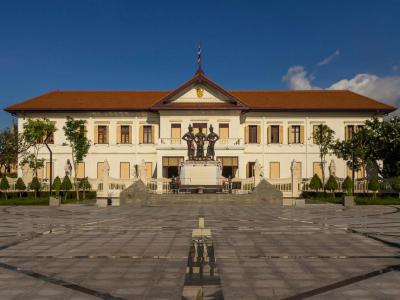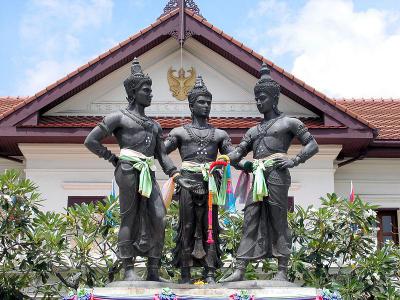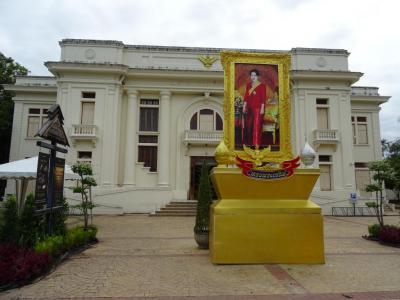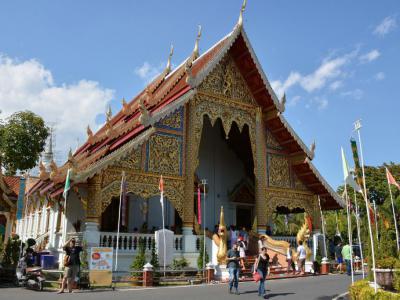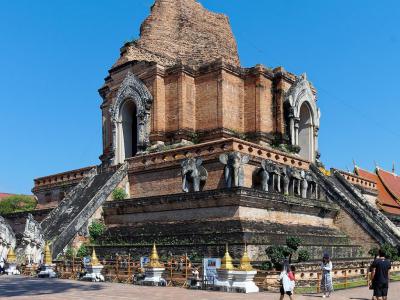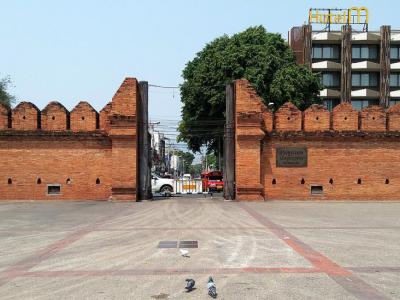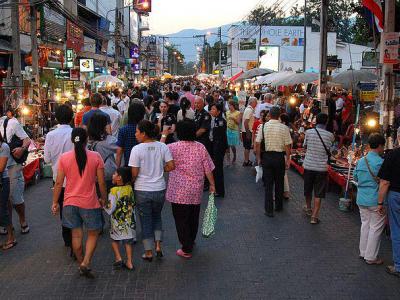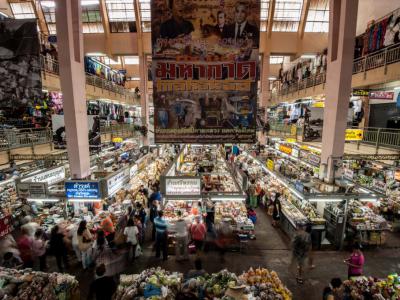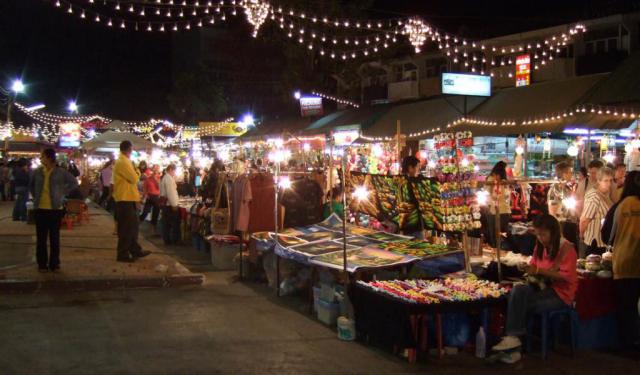
Chiang Mai Introduction Walking Tour (Self Guided), Chiang Mai
Situated in the mountainous northern part of Thailand, Chiang Mai ("New City" in Thai) was founded in 1296 as the new capital of the then independent Kingdom of Lan Na, succeeding its former capital, Chiang Rai. The strategic location on the Ping River (a major tributary of the Chao Phraya River) and its proximity to major trading routes contributed to the city's historic importance.
Chiang Mai's ruler Pha Yu enlarged and fortified it, and built Wat Phra Singh temple in honor of his father Kham Fu. In view of a constant threat from the nearby Taungoo Dynasty and the Mongol Empire, Chiang Mai was surrounded with a moat and a defensive wall.
Upon the decline of Lan Na, the city lost its importance and was occupied by the Taungoo in 1556. It then formally became part of the Thonburi Kingdom in 1775. Over the next century or so, Chiang Mai slowly regained cultural, trading and economic importance, and eventually progressed to becoming the unofficial capital of Northern Thailand.
In 2015, the city was on the tentative list for UNESCO World Heritage inscription. Indeed, Chiang Mai is a treasure trove of historic sights: vestiges of walls and moats, hundreds of intricately decorated Buddhist temples, including 14th-century Wat Phra Singh and 15th-century Wat Chedi Luang lavishly adorned with carved serpents. Also noteworthy is the Tha Pae Gate marking the entrance to the ancient walled city, a landmark structure and a regular scene of public gatherings and religious processions. And if you're off to some shopping for unique and authentic stuff or to try out the local street cuisine, the Tha Pae Road thoroughfare is the right place to be.
To experience the delights of Chiang Mai firsthand and explore the city's most prominent attractions, embark on this self-guided introduction walk.
Chiang Mai's ruler Pha Yu enlarged and fortified it, and built Wat Phra Singh temple in honor of his father Kham Fu. In view of a constant threat from the nearby Taungoo Dynasty and the Mongol Empire, Chiang Mai was surrounded with a moat and a defensive wall.
Upon the decline of Lan Na, the city lost its importance and was occupied by the Taungoo in 1556. It then formally became part of the Thonburi Kingdom in 1775. Over the next century or so, Chiang Mai slowly regained cultural, trading and economic importance, and eventually progressed to becoming the unofficial capital of Northern Thailand.
In 2015, the city was on the tentative list for UNESCO World Heritage inscription. Indeed, Chiang Mai is a treasure trove of historic sights: vestiges of walls and moats, hundreds of intricately decorated Buddhist temples, including 14th-century Wat Phra Singh and 15th-century Wat Chedi Luang lavishly adorned with carved serpents. Also noteworthy is the Tha Pae Gate marking the entrance to the ancient walled city, a landmark structure and a regular scene of public gatherings and religious processions. And if you're off to some shopping for unique and authentic stuff or to try out the local street cuisine, the Tha Pae Road thoroughfare is the right place to be.
To experience the delights of Chiang Mai firsthand and explore the city's most prominent attractions, embark on this self-guided introduction walk.
How it works: Download the app "GPSmyCity: Walks in 1K+ Cities" from Apple App Store or Google Play Store to your mobile phone or tablet. The app turns your mobile device into a personal tour guide and its built-in GPS navigation functions guide you from one tour stop to next. The app works offline, so no data plan is needed when traveling abroad.
Chiang Mai Introduction Walking Tour Map
Guide Name: Chiang Mai Introduction Walking Tour
Guide Location: Thailand » Chiang Mai (See other walking tours in Chiang Mai)
Guide Type: Self-guided Walking Tour (Sightseeing)
# of Attractions: 8
Tour Duration: 2 Hour(s)
Travel Distance: 3.3 Km or 2.1 Miles
Author: vickyc
Sight(s) Featured in This Guide:
Guide Location: Thailand » Chiang Mai (See other walking tours in Chiang Mai)
Guide Type: Self-guided Walking Tour (Sightseeing)
# of Attractions: 8
Tour Duration: 2 Hour(s)
Travel Distance: 3.3 Km or 2.1 Miles
Author: vickyc
Sight(s) Featured in This Guide:
- Chiang Mai City Arts and Cultural Centre
- Three Kings Monument
- Lanna Folklife Museum
- Wat Phra Singh
- Wat Chedi Luang
- Tha Pae Gate
- Tha Pae Road
- Warorot Market
1) Chiang Mai City Arts and Cultural Centre
The Chiang Mai City Arts and Cultural Centre is a museum dedicated to the history and culture of the city. It is located in the old city behind the Three Kings Monument.
A historic building that was once the City Hall houses the Chiang Mai City Arts and Cultural Centre. It was built in 1924 on the site of a former Royal Hall. The Royal Society of Siamese Architects gave an award to the center in 1999 for the efforts made in preserving the historical structure. The building is square shaped and has two floors that now contain the offices and display halls of the museum.
The front part of the Chiang Mai City Arts and Cultural Centre has halls where the permanent exhibits are displayed. The rear part consists of a hall where temporary themed exhibits are held, a hall dedicated to Lanna era arts, a souvenir shop and the archives of the museum. An orientation video is screened for the benefit of tourists. The film is in Thai with English subtitles. The permanent exhibits are divided into three sections. On sections has displays about the history of Chiang Mai, another section is dedicated to its culture and a third is dedicated to the role of Buddhism in the history and culture of the region.
A historic building that was once the City Hall houses the Chiang Mai City Arts and Cultural Centre. It was built in 1924 on the site of a former Royal Hall. The Royal Society of Siamese Architects gave an award to the center in 1999 for the efforts made in preserving the historical structure. The building is square shaped and has two floors that now contain the offices and display halls of the museum.
The front part of the Chiang Mai City Arts and Cultural Centre has halls where the permanent exhibits are displayed. The rear part consists of a hall where temporary themed exhibits are held, a hall dedicated to Lanna era arts, a souvenir shop and the archives of the museum. An orientation video is screened for the benefit of tourists. The film is in Thai with English subtitles. The permanent exhibits are divided into three sections. On sections has displays about the history of Chiang Mai, another section is dedicated to its culture and a third is dedicated to the role of Buddhism in the history and culture of the region.
2) Three Kings Monument
Located in the center of Chiang Mai, in the area where palaces used to stand, the Three Kings Monument is dedicated to the three Northern Lao Kings who founded the city of Chiang Mai. It is the venue of the King’s birthday celebrations in early December annually.
The Three Kings Monument consists of the bronze statues of King Mengrai, the founder of Chiang Mai and his two friends, King Ramkamhaeng of Sukhothai and King Ngam Muang of Payao, who are believed to have worked together to build the city. This has become an iconic part of the city and is reproduced in different forms and installed in different parts of Chiang Mai. There is a square in front of the monument which is the venue for many festivals. The square is surrounded by restaurants serving western food; close-by is also the office of Thai Airways.
The Three Kings Monument is located inside the city walls at the center of the old city. The monument stands in front of the Old Provincial Hall building which is today the City Art and Culture Center. The locals regard the monument as a shrine for the three kings. They offer flowers, incense and candles to the statue to invoke the blessings of these great Kings who conceived of the idea of the city of Chiang Mai.
Tip:
If you visit Chiang Mai during the Loy Krathong Festival (usually in November), this is an absolute must-see. All the grounds have the most beautiful lanterns and decorative animals on display.
At any other time, there are two museums surrounding (one behind and one in front), so to combine all three would be worth it.
The Three Kings Monument consists of the bronze statues of King Mengrai, the founder of Chiang Mai and his two friends, King Ramkamhaeng of Sukhothai and King Ngam Muang of Payao, who are believed to have worked together to build the city. This has become an iconic part of the city and is reproduced in different forms and installed in different parts of Chiang Mai. There is a square in front of the monument which is the venue for many festivals. The square is surrounded by restaurants serving western food; close-by is also the office of Thai Airways.
The Three Kings Monument is located inside the city walls at the center of the old city. The monument stands in front of the Old Provincial Hall building which is today the City Art and Culture Center. The locals regard the monument as a shrine for the three kings. They offer flowers, incense and candles to the statue to invoke the blessings of these great Kings who conceived of the idea of the city of Chiang Mai.
Tip:
If you visit Chiang Mai during the Loy Krathong Festival (usually in November), this is an absolute must-see. All the grounds have the most beautiful lanterns and decorative animals on display.
At any other time, there are two museums surrounding (one behind and one in front), so to combine all three would be worth it.
3) Lanna Folklife Museum
The Lanna Folklife Museum hosts exhibitions that tell the story of the Lanna people of Northern Thailand. The museum is located in Chiang Mai's old municipal court. The building has been renovated, and the exterior resembles a white colonial-style building.
Visitors will find 18 different exhibitions depicting the everyday life of the Lanna people. These dioramas include life-sized wax dolls in traditional costumes. Each diorama shows a specific feature of daily life. Visitors will learn about monastic life and the significance of religion and Buddhism to the Lanna people. Another diorama shows the dance rituals that were important to the Lanna people.
Visitors will also enjoy the pottery and ceramics exhibition. Admire the traditional fabrics and learn about the tools and methods the Lanna people used for farming.
Don't miss the detailed explanation of symbolism represented in Lanna-style monasteries. You can then interpret the intricate symbols on monasteries as you continue your travels in Chiang Mai.
Visitors will find 18 different exhibitions depicting the everyday life of the Lanna people. These dioramas include life-sized wax dolls in traditional costumes. Each diorama shows a specific feature of daily life. Visitors will learn about monastic life and the significance of religion and Buddhism to the Lanna people. Another diorama shows the dance rituals that were important to the Lanna people.
Visitors will also enjoy the pottery and ceramics exhibition. Admire the traditional fabrics and learn about the tools and methods the Lanna people used for farming.
Don't miss the detailed explanation of symbolism represented in Lanna-style monasteries. You can then interpret the intricate symbols on monasteries as you continue your travels in Chiang Mai.
4) Wat Phra Singh (must see)
Chaing Mai’s most important and sacred image of the Buddha, the Phra Buddha Singh is housed in the assembly hall of this ancient temple. Every year, during the Songkran festival, the statue is taken from the assembly hall and carried through the streets of Chiang Mai in a religious procession during which the spectators honour the statue by sprinkling water over it.
Wat Phra Singh was constructed by King Pha Yu to contain the ashes of his father, Kham Fu. In 1367, the Phra Singh image of the Buddha found its way to Chiang Mai from the Mahabodhi temple in Bodh Gaya in India. The temple gets its name from this statue of the Buddha with a unique lion style. The temple is guarded by stone lions.
The Wat Phra Singh complex consists of a large assembly hall or Viharn with a gilded copper image of the Buddha surrounded by white pillars supporting a red roof. The smaller assembly hall houses the Phra Singh statue. The hall is covered with paintings of the Buddhist folk tales – the Jataka tales. The Ubosot or ordination hall is perpendicular to the small Viharn and is decorated with elaborate mandala designs. The complex also contains a small monastic library and several Chedis including an old one dating back to 1345. The statue of Phra Singh is taken from the temple in procession around Chiang Mai during the Songkran or Thai New Year festival annually.
Why You Should Visit:
This is indeed one of the largest temples in the city, and also one of the prettiest, with a peaceful atmosphere.
There is also the possibility of talking to monks and having one or more days of Buddhism and meditation classes.
Tip:
The monks here are serious and prefer not to have pictures of the Buddha statues, believing this to be disrespectful. They also discourage the use of the Buddha as art, asking that representations be confined to shrines, whether public or private.
Wat Phra Singh was constructed by King Pha Yu to contain the ashes of his father, Kham Fu. In 1367, the Phra Singh image of the Buddha found its way to Chiang Mai from the Mahabodhi temple in Bodh Gaya in India. The temple gets its name from this statue of the Buddha with a unique lion style. The temple is guarded by stone lions.
The Wat Phra Singh complex consists of a large assembly hall or Viharn with a gilded copper image of the Buddha surrounded by white pillars supporting a red roof. The smaller assembly hall houses the Phra Singh statue. The hall is covered with paintings of the Buddhist folk tales – the Jataka tales. The Ubosot or ordination hall is perpendicular to the small Viharn and is decorated with elaborate mandala designs. The complex also contains a small monastic library and several Chedis including an old one dating back to 1345. The statue of Phra Singh is taken from the temple in procession around Chiang Mai during the Songkran or Thai New Year festival annually.
Why You Should Visit:
This is indeed one of the largest temples in the city, and also one of the prettiest, with a peaceful atmosphere.
There is also the possibility of talking to monks and having one or more days of Buddhism and meditation classes.
Tip:
The monks here are serious and prefer not to have pictures of the Buddha statues, believing this to be disrespectful. They also discourage the use of the Buddha as art, asking that representations be confined to shrines, whether public or private.
5) Wat Chedi Luang (must see)
The Wat Chedi Luang is a large ruined temple located in the heart of the old city area of Chiang Mai. It gets its name from the large Chedi or Stupa that once formed part of the temple complex.
The construction of Wat Chedi Luang was begun by King Saen Muang Ma to hold the ashes of his father, Ku Na. His successors further expanded the temple and construction was completed in 1475. At the time, it housed the Emerald Buddha regarded as the holiest religious object in Thailand. In 1575, the temple fell to ruin and was never rebuilt. In the 1990s, the UNESCO and the Japanese Government built a new Chedi in Central Thai style rather than in the traditional Lanna style of other temples in Chiang Mai.
Visitors can still see the old brick wat. The large stairway that leads to the temple is guarded by stone figures of mythical snakes and elephants. The large Viharn or assembly hall has a brass statue of a standing Buddha installed by King Saen Muang Ma. He also planted the ancient Dipterocarp tree in the grounds. It is believed that a great catastrophe will befall the city when the tree falls. A small cross-shaped building adjacent to the tree houses the city pillar dedicated to the spirit of the city. The tree and the spirit are said to protect Chiang Mai from evil and disaster.
Why You Should Visit:
If you want to see the monks chanting, this is the best place to go. Twice a day, 8am and 5:30pm, monks gather in the main hall to chant.
Tip:
If possible, go at (or stay until) nightfall to walk around this one. You can feel the peacefulness and the ambiance going after dark because these parts of the city are full of magic!
The construction of Wat Chedi Luang was begun by King Saen Muang Ma to hold the ashes of his father, Ku Na. His successors further expanded the temple and construction was completed in 1475. At the time, it housed the Emerald Buddha regarded as the holiest religious object in Thailand. In 1575, the temple fell to ruin and was never rebuilt. In the 1990s, the UNESCO and the Japanese Government built a new Chedi in Central Thai style rather than in the traditional Lanna style of other temples in Chiang Mai.
Visitors can still see the old brick wat. The large stairway that leads to the temple is guarded by stone figures of mythical snakes and elephants. The large Viharn or assembly hall has a brass statue of a standing Buddha installed by King Saen Muang Ma. He also planted the ancient Dipterocarp tree in the grounds. It is believed that a great catastrophe will befall the city when the tree falls. A small cross-shaped building adjacent to the tree houses the city pillar dedicated to the spirit of the city. The tree and the spirit are said to protect Chiang Mai from evil and disaster.
Why You Should Visit:
If you want to see the monks chanting, this is the best place to go. Twice a day, 8am and 5:30pm, monks gather in the main hall to chant.
Tip:
If possible, go at (or stay until) nightfall to walk around this one. You can feel the peacefulness and the ambiance going after dark because these parts of the city are full of magic!
6) Tha Pae Gate
The Tha Pae Gate is the entrance to the old walled city of Chiang Mai. It is a landmark structure and the venue of many public gatherings and religious processions all year round.
The Tha Pae Gate was built in 1296 during the reign of King Mengrai, the founder of the city of Chiang Mai. The eight main gates of the old city face a specific direction according to the eight compass points and each has an astrological faculty. The Tha Pae Gate faces east and has the astrological faculty of Mula or prosperity. Historically, it was the main gate that visiting monks, traders and diplomats had to pass to reach Chiang Mai.
Some important annual events that take place near Tha Pae gate are the annual Flower Carnival in February, the Songkarn or the Thai New year celebrations in April and the Loy Krathong festival. It is also a meeting point for rural people and the city folk. On Saturday nights a live band performs at the permanent stage on the square in front of Tha Pae Gate. Many stalls that form part of the walking street- Ratchadamnoen Road Sunday market are set up near the gate and stalls selling local delicacies provide food and drink for the hungry visitor.
The Tha Pae Gate was built in 1296 during the reign of King Mengrai, the founder of the city of Chiang Mai. The eight main gates of the old city face a specific direction according to the eight compass points and each has an astrological faculty. The Tha Pae Gate faces east and has the astrological faculty of Mula or prosperity. Historically, it was the main gate that visiting monks, traders and diplomats had to pass to reach Chiang Mai.
Some important annual events that take place near Tha Pae gate are the annual Flower Carnival in February, the Songkarn or the Thai New year celebrations in April and the Loy Krathong festival. It is also a meeting point for rural people and the city folk. On Saturday nights a live band performs at the permanent stage on the square in front of Tha Pae Gate. Many stalls that form part of the walking street- Ratchadamnoen Road Sunday market are set up near the gate and stalls selling local delicacies provide food and drink for the hungry visitor.
7) Tha Pae Road
The shopping street between Chiang Mai's Narawat Bridge and Tha Pae Gate is filled with exciting and unique finds. You'll find rare antiques, gorgeous textiles, and traditional clothing. Orchids and flowers add to the vibrancy of this shopping street.
Tha Pae Road closes to street traffic at 4:00 pm every Sunday. The street transforms into a busy night market. You'll find hundreds of stalls offering street food, souvenirs, textiles, clothes, and trinkets. Search for your favorite handicraft; friendly bargaining is acceptable. You might find the perfect silk scarf, spice collection, wooden carving, or gold Buddha image.
The temples along the road become delectable food courts. Try everything from deep-fried crickets to pancakes on sticks, to mango sticky rice, to fresh juice.
Artists can draw a street portrait or caricature for a unique souvenir. Stages are set up, and locals partake in dance recitals and performance arts while musicians entertain along the way.
When you're feet get tired, it's time to take a break and refresh yourself with a fresh juice and a foot massage.
While the shopping is fantastic, you'll also love the immersive cultural experience as locals and tourists come together to enjoy shopping, haggling, and tasty treats.
Tha Pae Road closes to street traffic at 4:00 pm every Sunday. The street transforms into a busy night market. You'll find hundreds of stalls offering street food, souvenirs, textiles, clothes, and trinkets. Search for your favorite handicraft; friendly bargaining is acceptable. You might find the perfect silk scarf, spice collection, wooden carving, or gold Buddha image.
The temples along the road become delectable food courts. Try everything from deep-fried crickets to pancakes on sticks, to mango sticky rice, to fresh juice.
Artists can draw a street portrait or caricature for a unique souvenir. Stages are set up, and locals partake in dance recitals and performance arts while musicians entertain along the way.
When you're feet get tired, it's time to take a break and refresh yourself with a fresh juice and a foot massage.
While the shopping is fantastic, you'll also love the immersive cultural experience as locals and tourists come together to enjoy shopping, haggling, and tasty treats.
8) Warorot Market (must see)
Warorot Market is the oldest and largest market in northern Thailand. This market is located by the Mae Ping River. Traditionally, most produce was delivered by boats traversing the river.
Today, you can find all the northern spices and foods that are hard to find elsewhere. You can find northern Thai sausage, northern Thai green chili paste, and dried fruit. Shoppers will be delighted by the variety of clothes, souvenirs, and handicrafts. Find yards of colorful fabric, buy fresh flowers, candy, nuts, or stock up on ingredients for dinner.
While tourists love this vibrant market, it's an essential shopping destination for locals. Vendors sell household goods such as woks, tiny statues, pickled tea leaves, and rice steamers. Peruse local fruit vendors and take your pick of lychees, mangosteens, longans, and rambutans.
You'll find lots of street food stalls to keep you going. Try the mouth-watering Khao Soi soup or fried pork. If you're still in the shopping mood, you can wander over to the Talat Ton Lam Yai flower market.
Today, you can find all the northern spices and foods that are hard to find elsewhere. You can find northern Thai sausage, northern Thai green chili paste, and dried fruit. Shoppers will be delighted by the variety of clothes, souvenirs, and handicrafts. Find yards of colorful fabric, buy fresh flowers, candy, nuts, or stock up on ingredients for dinner.
While tourists love this vibrant market, it's an essential shopping destination for locals. Vendors sell household goods such as woks, tiny statues, pickled tea leaves, and rice steamers. Peruse local fruit vendors and take your pick of lychees, mangosteens, longans, and rambutans.
You'll find lots of street food stalls to keep you going. Try the mouth-watering Khao Soi soup or fried pork. If you're still in the shopping mood, you can wander over to the Talat Ton Lam Yai flower market.
Walking Tours in Chiang Mai, Thailand
Create Your Own Walk in Chiang Mai
Creating your own self-guided walk in Chiang Mai is easy and fun. Choose the city attractions that you want to see and a walk route map will be created just for you. You can even set your hotel as the start point of the walk.
Shopping and Food Walking Tour
One of the reasons tourists visit Chiang Mai is shopping. Indeed, this city is fit to captivate anyone with its shopping opportunities, especially when it comes to diverse and unique goods such as silk, silver, clothing, ceramics, antiques, Buddhist art, lacquer and neilloware, of consistently good value and quality and at affordable prices. Chiang Mai is one of the cheapest places to shop in... view more
Tour Duration: 1 Hour(s)
Travel Distance: 1.3 Km or 0.8 Miles
Tour Duration: 1 Hour(s)
Travel Distance: 1.3 Km or 0.8 Miles
Chiang Mai Temples Walking Tour
Amid the multitude of impressive sights in Chiang Mai, religious temples really stand out. The city isn't just about one or two of them but has over 300 ‘wats’, which is more than elsewhere in Thailand. Some of these temples are as old as the city itself and were built by the kings not only to demonstrate their faith, but also to show off their wealth and power.
In the past, apart from... view more
Tour Duration: 1 Hour(s)
Travel Distance: 2.5 Km or 1.6 Miles
In the past, apart from... view more
Tour Duration: 1 Hour(s)
Travel Distance: 2.5 Km or 1.6 Miles
The Most Popular Cities
/ view all
